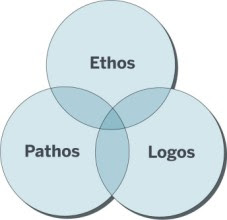
And Gillette's coming for your heartstrings to give them a big ol' tug. We're talking about the challenge of life as a trans man, too. Because we're not just talking about shaving.

Suddenly, when Samson's dad tells him not to be scared, it takes on a whole new meaning. But there's a twist: the son in the ad is transgender activist Samson Bonkeabantu Brown.
#Pathos ethos logos how to
The concept is simple – a dad teaching his son how to shave for the first time. It's the very definition of 'all the feels'. Interested in harnessing the power of pathos as a means of persuasion? Here are a few examples of pathos-packed adverts out in the wild. These three principles are the foundation of rhetoric. For Aristotle, a good argument would contain all three. These principles differed in how they persuaded: ethos is an ethical appeal. Throw in sadness and anger, too, and you're nearly there. Aristotle proposed there were three principles used in making an argument: ethos, pathos, and logos. That’s all pathos.ĭon Draper was nearly right when he said: 'Advertising is based on one thing: happiness'. They might also make their audience feel angry towards something, so that they're motivated to take action. When we talk about ‘feeling all the feels’, that’s pathos.Īdvertisers often use pathos to appeal to an audience's emotions, like making them feel sorry for their subject. It’s when we ‘tug on the heartstrings’ or ‘dial up the emotions’. Pathos is when we use emotional appeal – rather than logical arguments – to get people to do something. It’s the root of the words empathy and pathetic. Pathos is a Greek word that means both suffering and experience. Regardless of what appeals you use in your writing, it is important to be aware of fallacies (errors in reasoning) because they can reduce the impact of your message on your reader.Pathos, as demonstrated by Pencil the Dog What is the definition of Pathos? Layout, graphic design choices, white space, style and tone: all of these factors influence your ethos. Reliable, appropriate sources act as expert voices that provide a perspective you don’t have. You can also gain ethos through your use of sources. It’s much easier to encourage a disagreeable audience to listen to your point of view if you have convinced them that you respect their opinion and that you have established credibility through the use of logos and pathos, which show that you know the topic on an intellectual and personal level. This is especially important when writing an argument to an audience who disagrees with you. (See logos.) It’s also what you do to assure them that they are good people who want to do the right thing. Latin for ethics, ethos is what you do to prove to your audience that you can be trusted, that you are a credible source of information. Ethos is a type of persuasive strategy where someone tries to establish themselves as an authority on the topic at hand, while logos is where someone presents. However, if you only rely on logos, your writing might become dry and boring, so even this should be balanced with other appeals. Thousands of years ago, Aristotle provided us with three ways to appeal to an audience, and theyre called logos, pathos, and ethos. Your audience will question the validity of your claims the opinions you share in your writing need to be supported using science, statistics, expert perspective, and other types of logic. Latin for logic, logos is where those facts come in. Many donations campaigns draw on pathos, such as this classic ASPCA ad: Too much pathos can make your audience feel emotionally manipulated or angry because they’re also looking for the facts to support whatever emotional claims you might be making so they know they can trust you.


People tend to have emotional responses before their brains kick in and tell them to knock it off. Latin for emotion, pathos is the fastest way to get your audience’s attention.


 0 kommentar(er)
0 kommentar(er)
